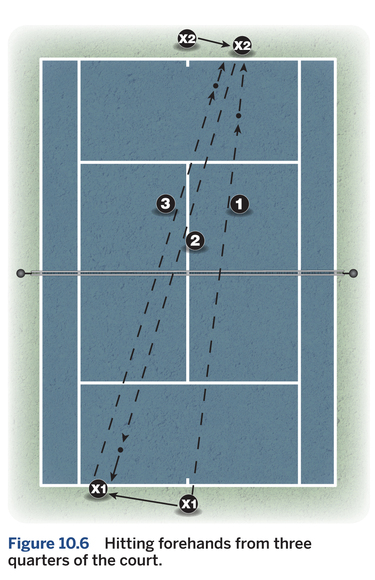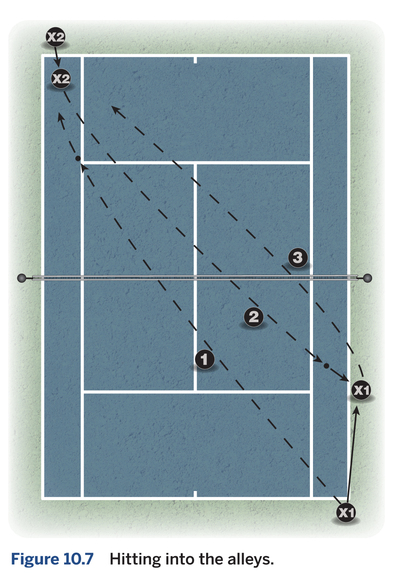Strategies are plans that give a player a sense of purpose when on the tennis court and that build on the common patterns of play. Simply put, the player executes shots in combinations that the player feels confident with and that help the player dictate play and win points.
The player’s level of skill and specific shots (weapons) determine which of the following strategies to focus on and tailor to the player’s individual style. For example, players who want to employ the strategy of pulling an opponent off the court should have a good inside-out forehand, have wide serves, and be able to use angles. Players can always add shots to enhance their game and add variety, but the strategy they should use most is the one that matches the shots they can hit consistently and with confidence.
All advanced strategy is based on fundamental strategy; advanced players are advanced because they didn’t skip over the fundamentals. Understanding the true meaning of the shots and how they fit into the individual overall game plan gives the player a foundation of knowledge to build on. The following strategies build from fundamental to advanced.
Basic Strategy #1: Hitting to the Open Court
In this strategy, the player hits the ball to where the opponent is not standing. This strategy begins a player’s development of soft focus, which is seeing where the opponent is while focusing on the player’s own court positioning and the incoming ball. The player will start using ball control in an attempt to get the ball to the open court.
Common patterns of play: One-to-one pattern, hitting the ball deep, short, high, low (defensive, rally or attack phase).
Basic Strategy #2: Covering a Weakness
When the goal is to hit a weapon in a rally, the player can use the tactic of running around the weakness. Doing so takes great speed and athleticism. Consistently running around a weakness does not improve the weakness, so this tactic relegates a player to this style of play; all subsequent shots have to be developed to help that strategy.
The most popular weakness initially is the backhand, so the inside-out forehand is the answer. To effectively run around a weakness, the player must look for a short, midcourt ball with slower pace and more height. (The Three-Quarter Court drill in the upcoming strategy can help players practice covering for a weakness.) Alternatively, to set up the opponent to hit to a strength, the player can recover to the weaker side, leaving more room to hit the stronger stroke. Recovering to the weaker side also shrinks the court for the opponent, making it harder to hit it to the weakness. This is the goal of proper court positioning.
Common patterns of play: One-to-one, one-to two, and two-to-one patterns keeping the ball crosscourt as often as possible.
Basic Strategy #3: Weapon to Weakness
For most players, the serve and the forehand are the main weapons in their games. However, it doesn’t mean a backhand, speed, or net play can’t also be developed and used as weapons. Whatever the player’s strengths may be, the goal when playing winning tennis is getting in position to hit a weapon to the opponent’s weakness. The best way to do this is to use the three-quarter court strategy. This strategy says the player will try to be positioned midway between the middle hash mark and the alley on the baseline or near the baseline on the side of the player’s weaker shot. The player will recover to this location on rallies, after a serve, and after a return. Because the opponent is hitting his or her strength, the opponent’s net play could improve as a result of hitting a more effective approach shot, too.
Common patterns of play: One-to-one, two-to-two, two-to-one, and neutralizing (by keeping the ball up the middle of the court).
Three-Quarter Court Drill

Purpose: To teach how to cover a weakness and use a weapon.
Procedure: Both players start in the middle of the baseline on opposite sides of the court (see figure 10.6). Player 1 feeds a ball to land midway between the middle of the baseline and the alley near the baseline. Player 2 runs around the backhand and hits a forehand inside out to midway between the middle of the baseline and alley near the baseline. Player 1 responds by running around the backhand and also hitting an inside-out forehand. After two inside-out forehands have been hit, the players play the point out whole court. The first person to 7 points wins the round; players play to the best of 5 rounds.
Coaching points: This strategy is usually used when the forehand is the weapon and the player wants to be in a position to hit more forehands in a match. For drilling to strengthen one’s backhand, the player can also practice running around the forehand, but this is not recommended for match play.
Intermediate Strategy #1: Pulling an Opponent off the Court
This strategy is used to test an opponent’s ability to move and also is a great way to open up the court. There are a variety of ways to pull your opponent off the court, including a deeper crosscourt ball or a shorter-angled crosscourt shot. A serve and return can also be played to pull the player off the court as well as a volley. How powerful and well placed this shot is hit, dictates the player’s next shot. A weaker shot that misses its mark can give the opponent an easier next shot. A powerful and well-hit crosscourt shot can force an error or a short ball.
The goal of pulling a player off the court is to hit the next shot into the open court or behind the opponent to wrong-foot the opponent. Two very common plays are to hit a forehand or backhand crosscourt and then hit the next ball down the line. The player can use this strategy with the rush-and-crush strategy (Intermediate Strategy #2) to put additional pressure on the opponent.
Common patterns of play: One-to-one, one-to-two, and two-to-one patterns.
Alley Drill

Purpose: To emphasize hitting the outside of the ball and opening the court to pull the opponent off the court.
Procedure: Each player stands on the deuce side of the court and behind the doubles alley on each side of the court. Player 1 feeds the ball into play and aims for player 2’s doubles alley (see figure 10.7). Player 2 responds by also hitting to player 1’s alley. After two alley shots are executed, the point is played in the singles lines only. Each player should hit on the outside of the ball with the intent of opening the court. The feed does not count as a point but every forehand crosscourt hit into the alley does count as a point. The game is played to 7 points and then switched to the backhand side. Players should also alternate between being player 1 and player 2.
Coaching points: Spin and height are essential for winning this game. The player should relax and continue to accelerate on the ball.
Variation: Players can play this game from around the service line to develop angles, midway between the service line and baseline to develop a heavy rally ball, and deep behind the baseline to practice hitting from a defensive phase.
Intermediate Strategy #2: Rush and Crush
With rush and crush, the player is looking for ways to get to the net. Several plays can be used to execute this strategy, starting with the serve-and-volley or return-and-volley. Or, the player can get an opponent on defense with a weapon and move in to hit a swinging volley or block volley. Another option is to throw up a high, heavy ball to the opponent’s weakness and sneak in behind it. Or, the player can hit a drop shot, bring the opponent forward, and then lob over the opponent, approaching the net as the opponent runs back to recover the shot.
Common patterns of play: Serving and volleying, chipping the return or hitting and coming in, or transitioning shots of any kind are used to rush and crush. With the strategy of rushing and crushing, the player is taking every opportunity to get to the net, including one-to-one, two-to-two, and two-to-one neutralizing patterns of play. Players can also use short to deep shots to transition to the net.